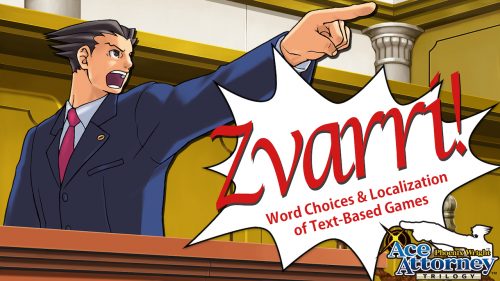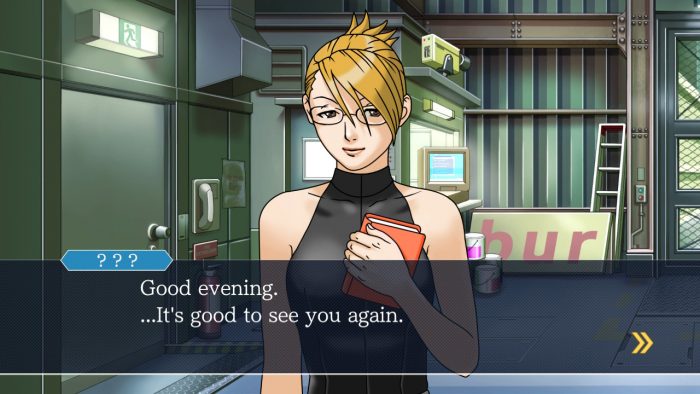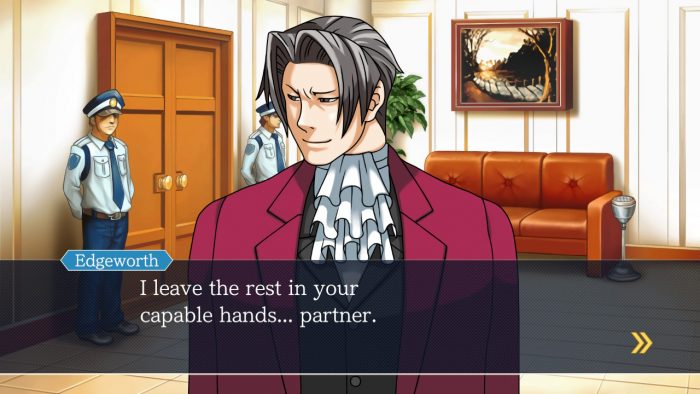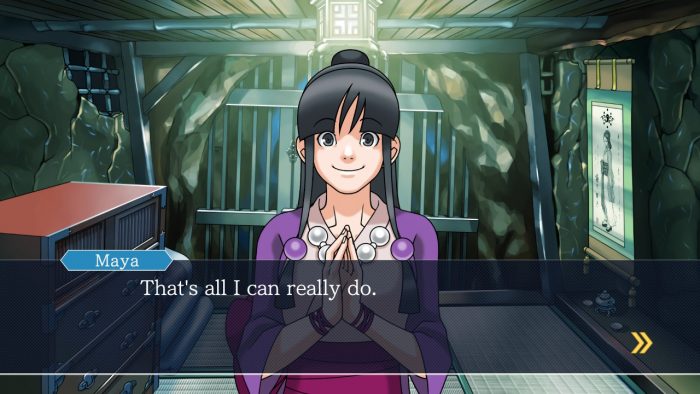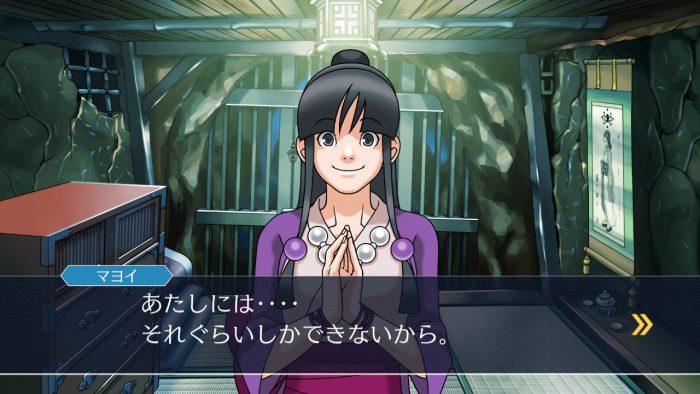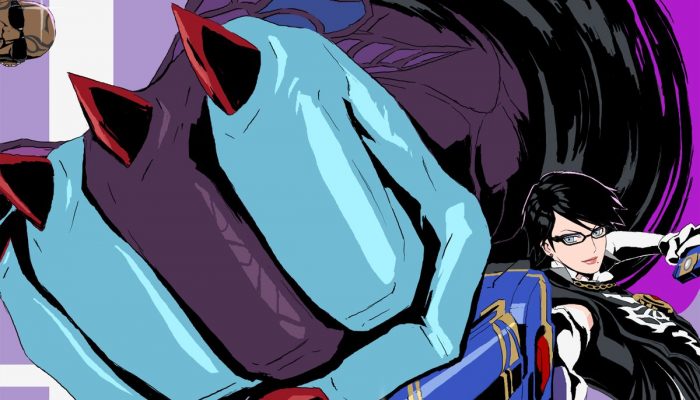 In the case of a text-based game where there is no voice acting, word choices are the only tools a translator has to shape how a player perceives the characters and their growth.
In the case of a text-based game where there is no voice acting, word choices are the only tools a translator has to shape how a player perceives the characters and their growth.
☆ NintendObs Weekly – Monday, April 1, 2019 – Sunday, April 7, 2019.
Zvarri! Word Choices & Localization of Text-Based Games
APR 5
Hello again! This is Janet Hsu, back one last time before Phoenix Wright: Ace Attorney Trilogy goes on sale next Tuesday, April 9th! Today, I’d like to talk a little about something that’s an integral part of any good translation: word choice.
*Warning: Spoilers for the entire trilogy abound!
*If you want to know more about everyone’s favorite interjection, “Zvarri!”, check out this entry.
Much of what we infer about game characters is told through the nuances in the characters’ lines, which voice actors and their performances greatly contribute to in a voiced game. But in the case of a text-based game where there is no voice acting, word choices are the only tools a translator has to shape how a player perceives the characters and their growth. Complicating matters more for the Ace Attorney series is the extremely limited on-screen real estate we had on the Nintendo DS (we could only fit 28 letters x 3 lines worth of text at the time). This meant that each word we used had to pull its weight in establishing the characters’ “voices.” Those of you who have played the games before can probably attest to this, but you can pretty much pick out any line in the games and know which character said it based on the words and phrasing it contains.
And on that note, come with me now on a trip down memory lane as I take a look at a few of my favorite moments from the trilogy and the word choice considerations I gave to the character dialogue in those sections.
One of the characters I really connected with was Adrian Andrews, so naturally, one of my favorite scenes was her return in “Trials and Tribulations” as a happier version of herself. While I was genuinely happy to see a returning character make strides to move forward with her life, I also liked that she wasn’t magically “perfectly fine,” either. Not that I’ve experienced even a fraction of the drama in her background, but I think everyone has experienced a moment of low self-esteem or lack of confidence at some point in their life, so Adrian’s appearance in “Justice For All” was relatively easy for me to write thanks to life experiences that I could draw on. But for “Trials and Tribulations”, one of the things I had to balance was her cheerier disposition and her occasional slip back into a darker place. If I had made her too bubbly, there was the possibility that the scenes where she’s being down on herself for breaking the Sacred Urn would seem inconsistent and create some major tonal whiplash.
Every writer has their own approach to creating characters’ voices. The way I tend to write when I localize is to first envision a character’s inner life based on what the original Japanese text and the character’s animations provide. For example, are they highly-educated, or are they more street smart? Are they going through anything or are they living a pretty stress-free life? After I have a sense of what tone I’m going for, I flesh out a character’s word choices with what’s going on in the story as well as their perspective and/or motives for being involved in the case to begin with.
In the case of Adrian’s entrance in “Trials and Tribulations”, her first line directed at Phoenix and gang is the line in the screenshot above: “Good evening. …It’s good to see you again.” Now, I could have written this line as “Evening. It’s been a while,” but in the context of the dialogue to follow, I felt that a phrasing like the latter lacked the familiarity and warmth required for her next line to Pearl to be:
That’s why I went for a phrasing that included a positive word like “good” in her greeting. But what about the ellipses at the beginning of the sentence? We certainly don’t use them much (if ever) in proper English writing, and I remember having many a discussion with fellow localizers at the time about which ellipses we should keep from the Japanese and which were “excessive” by English writing standards. In this case, I decided we had to keep it because it served the function of showing her moment of hesitation. In my mind, this was Adrian’s first time seeing Phoenix and Pearl since the trial at the end of the second game where her tampering with the crime scene had caused them quite the headache. It seemed only natural to me that she would pause before deciding what to say next in this situation.
Given how sparingly Edgeworth was used after the first game, each of his appearances is positively loaded with character growth that needed to be reflected in the translation. That’s why another scene I really love is the one where Edgeworth says to Phoenix, “And with that… I leave the rest in your capable hands… partner.” (‥‥それでは‥‥ あとは、たのんだぞ。‥‥相棒。) It’s one of the lines in “Trials and Tribulations” that best shows just how far Edgeworth has come. Remember, this is the man who started as a total brat who trusted no one that wasn’t named “von Karma,” who didn’t know how to thank Phoenix and Maya for saving his life, and who could only awkwardly “Whooooooop!” before running away in embarrassment from Gumshoe at the end of the first game.
In translating this line, it was tough to get the nuance just right because, in the Japanese text, he says it kind of offhandedly (in that Edgeworth way that he does). But, due to the context in which it’s being said, it also has a strong underlying nuance of “I trust you to see this through to the end.” I could’ve translated the line more generically as: “Now… the rest is up to you… partner,” but to me, the standard translation “the rest is up to you” can also be interpreted as a very neutral “I’m passing the baton on to you” without the sense of “I believe in you / I trust you” that the Japanese implies. So, I decided to make that nuance a little more explicit with my word choice in the English.
You might have noticed that this is the second time I’ve mentioned making things more explicit in the English localized text when translating from the Japanese source text. I know some people might take that as me inserting myself into the translation, and while translator bias is definitely a thing, in the case of translating from Japanese to English, it is sometimes necessary to spell out what’s being said between the lines because the United States is an example of a “low context culture.” Very broadly speaking, this simply means that an American (and the English they use) is required by their culture to be more explicit in their wording to correctly convey their message. Meanwhile, due to the way Japanese culture works, a Japanese person can be vaguer in their wording and feel confident that a culturally shared understanding of the world and the context around their statement will ensure that their message is conveyed correctly to the listener / receiver. So, you see, I wouldn’t have been doing my job of conveying the proper sentiment as implied through context if I had left the wording of the English text just as ambiguous as the original Japanese because of how differently the two cultures work. You might even say that not spelling certain things out in English is precisely how things get “lost in translation.”
◆ Maya
The only reason I’m still here at all is thanks to everyone who was there for me.
◆ Pearl
…!
◆ Maya
My sis, my mother, Mr. Armando, Nick…
And… you.
If even one of you weren’t there, I’m sure I wouldn’t still be alive right now.
That’s why… I have to be strong.
For all the people that were there for me when I needed them.
That’s all I can really do.
The last favorite moment I’m going to share with you today is the scene from “Bridge to the Turnabout” from the final case of “Trials and Tribulations,” where Maya shows us her true inner strength. This scene is the culmination of several narrative and emotional threads: Maya just went through a harrowing ordeal and now has to deal with the loss of her mother for a second time, but she also has to comfort a very guilt-ridden Pearl who thinks that it’s all her fault. Furthermore, she must decide whether she wants to become the next Master and take on everything that doing so entails.
Maya’s lines and animations in this scene are unusually subdued. In fact, most of the lines before “That’s all I can really do” use her “neutral” animation with the last line as the one where she finally bounces back to being “cheery Maya” to bring her point home that everything is going to be okay. But, of course, her saying that being strong is “all she can really do” is just her being humble and showing appreciation for everyone in her life. Contrast that with her actual feelings of worthlessness at the end of “Turnabout Goodbyes,” the fourth episode of the first game:
◆ Maya
I’m the only one who couldn’t help. I was useless, Nick.
◆ Phoenix
But you were the one who stopped von Karma, Maya!
◆ Maya
Huh?
I-I didn’t do anything!
All I did was wander around in a daze…
In terms of word choice, this is one of the times where Maya is more serious, so her sentences lack her usual cheerfulness. Instead, they’re filled with more pauses as she puts her thoughts in order. While the last sentence in Japanese had ellipses and a dramatic pause in it, I felt that keeping them in the English translation with the animation it’s paired with would have made her resolute statement seem more hesitant and weaken the intended overall effect of reassuring Pearl.
“Atashi ni wa…. sore gurai shika dekinai kara.”
Literal translation: “Because I… That’s about all I can do.”
I hope you’ve enjoyed this glimpse into some of the word choice considerations I had to make when localizing the Ace Attorney series. There are so many other scenes I wanted to share, but I’m afraid I will have to save them for some other time. In the meantime, I hope I’ve given you a new way to look at the game and its characters as you play through it again starting April 9th!
Until then!
— Janet Hsu at Capcom
Source: Capcom Unity.
At NintendObserver, the comments are on Discord.
Click on Community to learn more. 🙂
…
…Wanna play? Buy a Switch.
And if you’ve already got yours, click on Phoenix Wright Ace Attorney Trilogy for everything you need to know about the game. 😀

